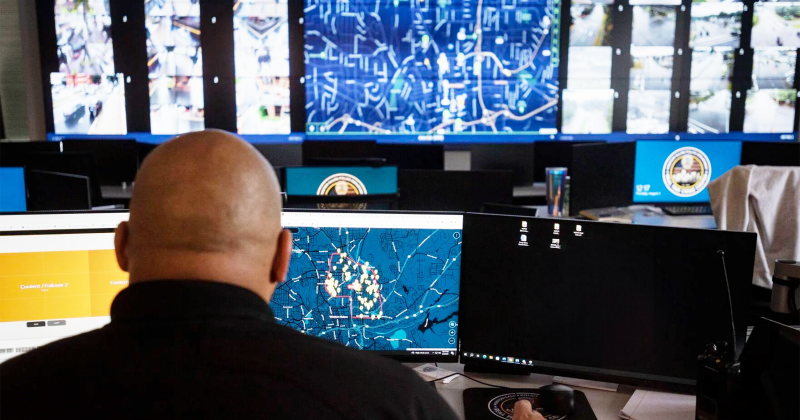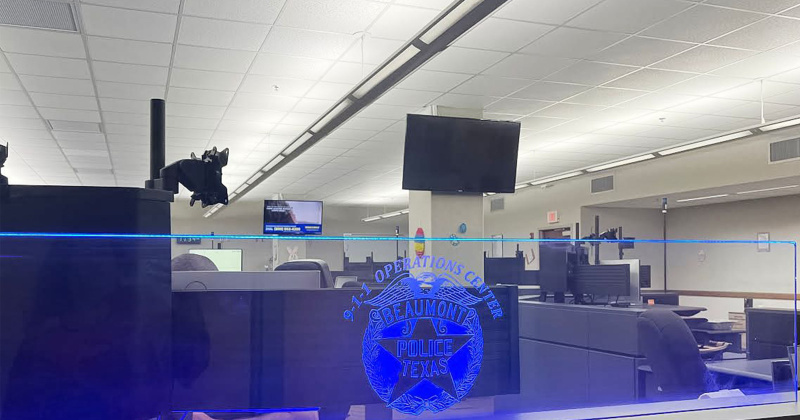The eyes of BPD are upon you
It’s a matter of working “smarter,” Beaumont Police Department (BPD) staff tasked with getting the city’s Real Time Crime Center online told The Examiner. Now just mere months away from completing the project that has been years in the making, key personnel are gearing up for the rollout of a crimefighting method that promises to bring proactive policing into a new paradigm.
“This is going to be a real gamechanger for us,” BPD Chief of Police Jimmy Singletary said. “It’s going to change the way we do police work.”
Real Time Crime Centers, such as the one in the works at BPD, utilize technological advancements and data sharing capabilities to combine use of a plethora of tools to deter and solve crimes. Among the equipment in the Real Time Crime Center arsenal are license plate readers, municipal cameras and red-light cameras, as well as private residence and commercial cameras from stakeholders that facilitate integrated use with law enforcement – and even live links to share cellphone camera access. Combined, BPD personnel in the department’s Real Time Crime Center use the surveillance techniques to assist officers in the field with dispatch updates, live footage of crimes in progress, and investigation in real-time of serious crime committed throughout the city.
“It’s going to help us so much,” Singletary said. “I’m just blown away about what it is going to do.”
Soft launch
The Bureau of Justice Assistance (BJA), a component of the Office of Justice Programs within the United States Department of Justice that provides leadership and assistance to local programs that “improve and reinforce” the criminal justice system, offered an official review and support for police agencies enlisting the use of a Real Time Crime Center (RTCC). The mission, as described by BJA, is to provide a law enforcement agency with the ability to respond to crime events more efficiently, more deliberately, with improved operational intelligence, and with a proactive emphasis on officer, citizen and community safety.
Real Time Crime Centers centralize a broad range of current and evolving technologies, coordinate sworn and/or nonsworn human resources, and direct the attention of both to high-crime areas, active crimes in progress, largescale public events that may require law enforcement presence or response, and/ or high-profile or highly recidivistic offenders in the community.
“In short,” BJA concluded, “an RTCC would maximize the likelihood that law enforcement can respond to crimes occurring in real time and do so effectively.”
The development of Real Time Crime Centers is a response to the police community’s desire to provide immediate information to officers during each call for service, according to the BJA, and are intended to initially triage information from a call for service and provide information, such as suspect vehicle descriptions, victim or suspect criminal histories and other pertinent information, on the fly to assist in furthering an officer’s investigation during a call.
The RTCC technology in its infancy at BPD has already elicited results that law enforcement can appreciate. BPD Assistant Chief of Police Wayne Jeffcoat recounted an incident of an auto burglary that recently took place at a Pine Street cemetery: A woman exited her car to put flowers on a grave, leaving her car door ajar momentarily; it took less than a moment for someone to rob her while she grieved.
“A car drives up; guy gets out, takes her purse and drives away,” Jeffcoat said. The victim, however, snapped a picture of the car as it sped off. “So, the officer shows up; and he’d just been trained on this.”
From his patrol car, the officer was able to access a license plate reader in use up the street from where the crime occurred and, using known details of the crime to narrow a window of time to find the vehicle of interest, the officer was able to locate the vehicle, the owner and the owner’s address within minutes.
“Basically, the officer that responded to take the report was able to solve it within 30 minutes,” Jeffcoat added. “That’s something that previously might have never been solved.”
The more, the merrier
With the “soft rollout” of the local RTCC this month, BPD has already secured 1,398 registered private cameras for law enforcement use, combined with 544 integrated and city of Beaumont cameras. The current number of Beaumont RTCC participants already surpasses many larger cities, such as Atlanta, Georgia, that have already fully launched RTCCs.
Public participation is predominantly credited to the hard work of BPD’s Brandon Garris and Sgt. Cody Courts.
“We’ve gotten a lot of interest to sign on,” Courts said, adding that he and Garris visited dozens of neighborhood associations, homeowner associations, schools and businesses to gauge concerns and solicit support prior to going fully online, targeting the end of July. Addressing fears of “Big Brother” behavior, Courts assured that all private camera usage is strictly consent-based and can be tailored depending on how much – or how little – the camera’s owner wishes to share.
“There’s even an option for them to only turn it on when we ask them to,” BPD Captain Tim Ocnaschek advised. Mostly, “We’re using existing (cameras scattered throughout the city that are the property of the city of Beaumont). If there is a gap identified, we have options.”
For Courts, the RTCC is tasked with respecting the community’s privacy while, at the same time, making the community safer for those who live in it.
“Everything is a balancing act,” he said. Courts then spoke of a woman from the South Park area that told him she was afraid to walk to the store; he hopes security surveillance will give her peace of mind to enjoy a stroll to the nearby gas station. “The ability to walk to the store and not be scared is a great thing to give to the public.”
Many of the cameras integrated with the BPD RTCC post signage indicating surveillance, as BPD is less interested in capturing hidden camera footage than it is in actively deterring crime before it happens, BPD Assistant Chief of Police Jason Plunkett shared.
“You pick what you share, when you share it,” Plunkett reiterated, stating a focus on wanting to garner public participation for public safety, and not troll lawful residents. “We want people to sign up.”
In addition to the cameras integrated online with BPD, the police department is working on securing agreements with other policing entities within Beaumont to expand the community network. Among the police agencies in talks with BPD are the Beaumont Independent School District, Lamar University, Lamar Institute of Technology and the Port of Beaumont. Once agreements are met, the system can likewise be utilized by all the participating policing agencies. Fusus software, used to bring all the technical capabilities of the RTCC network to one screen, can then be accessed by all the Beaumont law enforcement agencies.
Security + Safety
“We’ve already seen how this can be successful,” Plunkett said. “There’s all kinds of benefits to it.”
Enhanced ability to police is just the beginning; enhanced safety for police and suspects is also touted.
“Before, all we had to rely on is the caller, and the call,” Plunkett said. “Now, we have eyes there.”
“This is a dangerous job, and we get dangerous calls,” Plunkett continued, acknowledging danger increases for the officer and suspect alike the less information is known before contact. “The more information the officer has, the better we all will be.”
More manpower is needed to bring the full effect of a 24/7 RTCC to life – likely taking a few years to completely secure. Ocnaschek and Jeffcoat estimate a crew of approximately 16 needed, plus at least three sworn peace officers. Even then, the RTCC is a “force multiplier” for the manpower already on staff by streamlining policing, Plunkett said. Currently, the RTCC is a three-man skeleton crew.
“We’re trying to stretch our manpower,” Ocnaschek said, pointing to the RTCC mission to save money, time – and lives. “It stretches our ability to serve the community.”
Singletary agreed that more personnel is needed, and he hopes to add community supporters along the way, as well.
In all his 54 years in law enforcement, Singletary said, the advent of the RTCC will have the “biggest impact” in revolutionizing community policing.
The dispatch center of BPD processed over 300,000 calls for service in 2023; and officers were dispatched to more than 160,000 of those calls. Many times, Plunkett said, officers respond to scenes where the actor has already left and are crucial minutes behind in pursuit. With the RTCC, dispatch can pinpoint suspects on the move.
“We can only take this in baby steps right now,” though, Plunkett detailed. RTCC construction is currently underway, building out offices, a command center, and accompanying rooms for production. Upgrades are nearing the $10 million mark, mainly funded through grants secured by Ocnaschek and staff.
“It’s literally been two years trying to piece together funding,” Jeffcoat said of the hard work put in by Ocnaschek, which was likewise appreciated and met with support from the Beaumont City Council and City Manager Ken Williams. “This is a huge project, and they have all been on board since the beginning. Obviously, that makes it a lot easier.”
In fact, Jeffcoat added, “We couldn’t have done it without their support.”
“This is the biggest thing the Beaumont Police Department has been involved in with regards to fighting crime,” Singletary summed up of the initiative. “It’s going to help the community, but we need the community buy-in.
“The more citizens that support this, the more success we will all see.”
Beaumonters can visit connectbeaumonttx.org to register private security cameras with BPD, learn more about integrating with the RTCC software or purchase equipment.



